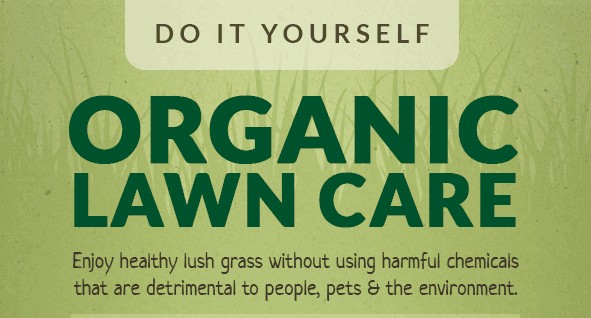Having a beautiful, green lawn doesn’t require harsh chemicals that can harm the environment, your family, or your pets. You can achieve a lush and healthy lawn by adopting a Do It Yourself Organic Lawn Care Program. This guide will provide you with a comprehensive schedule and practical tips to maintain a thriving organic lawn throughout the year, ensuring it’s safe for everyone to enjoy.
 Organic Lawn Care
Organic Lawn Care
Crafting Your DIY Organic Lawn Care Program
The secret to successful organic lawn care lies in understanding the timing and implementing the right steps at the right time. Below, we’ve designed a monthly schedule to guide you through the essential tasks. We also address common lawn issues and offer natural, DIY solutions to keep your lawn looking its best, naturally.
Essential Tools for Your Organic Lawn Care Journey
If you’re new to organic lawn care or just setting up your homeowner toolkit, here’s a list of tools and products you’ll need to get started on your do it yourself organic lawn care program:
- Organic Grass Seed: Choose a seed mix appropriate for your climate and sun exposure.
- Organic Fertilizer: Opt for a slow-release organic fertilizer to nourish your lawn naturally.
- Lawn Mower: A standard lawn mower, preferably with mulching capabilities.
- Thatch Rake: For removing built-up thatch and promoting healthy growth.
- Aerator: To improve soil aeration and nutrient absorption.
- Water Sprinkler: To ensure consistent and adequate watering.
- Corn Gluten Meal: A natural pre-emergent herbicide for weed prevention.
- Rake: For general cleanup and spreading materials.
- Wheelbarrow: For transporting materials like compost and fertilizer.
- Optional Scarifier: For more intensive thatch removal, especially for established lawns.
- Leaf Blower: For efficient leaf and debris cleanup.
- Garden Lime or Sulfur: To adjust soil pH based on soil test results.
- String Trimmer: For edging and trimming areas mowers can’t reach.
Your Monthly DIY Organic Lawn Care Schedule
March/Early Spring: Soil Prep and Initial Cleanup
As soon as the ground thaws, typically in March, it’s time to assess your soil health. Start by conducting a soil test to understand its pH and nutrient levels. A healthy lawn needs at least 6 inches of good quality soil. You can use a DIY kit, but for more accurate and often cost-effective results, consider sending a sample to your local extension office. They can provide tailored advice on soil amendments and grass types suitable for your area.
If your soil pH is below 6.0, incorporate garden lime to raise it. If it’s above 7.0, use garden sulfur to lower it. Local extension experts can offer specific guidance on soil amendments.
March is also the time for spring cleanup. Rake away any dead leaves, branches, and debris accumulated over the winter. These materials can be valuable additions to your compost pile. Aerate your lawn to relieve soil compaction caused by winter snow and foot traffic. Aeration allows water, air, and nutrients to penetrate deeply to the grass roots, promoting healthier growth.
Spring/Summer (Weekly & Bi-Weekly): Mowing and Watering
Once spring arrives, begin regular mowing and watering, typically weekly or bi-weekly, depending on grass type and weather conditions. Water deeply but infrequently, only when your lawn shows signs of drought stress (e.g., footprints remain visible on the grass). Aim for about 1 inch of water per watering session, which you can measure by placing a cup near your sprinkler.
Avoid the common mistake of mowing too short. Cutting grass too short weakens it and encourages weed growth. Taller grass blades shade the soil, retain moisture, and develop stronger root systems. For cool-season grasses, set your mower blades to 3.5-4 inches. For warm-season grasses, aim for 2.5-3 inches.
April & August: Composting (Top-dressing)
Apply a layer of compost to your lawn twice a year, ideally in April and again in August. This process, known as top-dressing, enriches the soil and boosts beneficial microbial activity, leading to thicker, greener grass. Compost is particularly beneficial for addressing thin or brown patches in your lawn.
April, July (Optional), & October: Organic Fertilizing
Apply an organic lawn fertilizer in April, and optionally in July if needed, and again in October. Organic fertilizers provide essential nutrients slowly and sustainably, improving soil health over time.
When choosing an organic fertilizer, consider brands like Ringer® Lawn Restore® Fertilizer, recommended by experts like Paul Wheaton from Rich Soil. He notes its safe ingredients, slow-release formula, and effectiveness in promoting healthy lawn growth.
Fall: Dethatching and Overseeding
Fall is the ideal time to dethatch your lawn, removing excessive thatch buildup that can hinder nutrient and water penetration. After dethatching, overseed any bare patches to encourage thick growth in the following spring. Overseeding in the fall allows new grass to establish roots before winter, leading to a fuller, healthier lawn next season.
By following this do it yourself organic lawn care program, you can achieve a beautiful, healthy, and safe lawn without relying on harmful chemicals. Enjoy a lawn that’s perfect for family time, picnics, and barefoot enjoyment all summer long.
